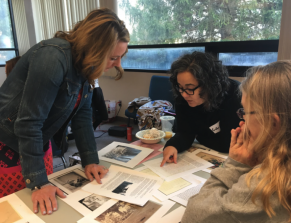“I’ve found that if I pick the right primary sources…[I can make the lesson more accessible]. For example, I just gave some students an evacuation poster (after Order 9066 [–forcing Japanese relocation to camps]) that was selected for its minimal text which was heavy on vocabulary they would know or be able to figure out such as dates and places. I gave other students letters to the editor about the Japanese American “evacuation” and internment, and also used political cartoons. When those groups can share what they learned about the effects of Order 9066, they all have valuable information the other groups didn’t have and it contributes to the whole’s understanding” – Wendy
Students who struggle with reading can have a hard time in social studies and history classes. Teachers in Accessing Inquiry through Primary Sources courses have been using a variety of methods to help. Recent comments from teachers (see above and below) highlight ways that, even before taking other steps to make content more accessible to struggling learners, having students examine letters, cartoons, posters, and photos and drawings of events and places can overcome barriers for participation by students.
Teaching with primary source sets that assemble a variety of types of documentation can be one way to provide students different entry points to the lesson content. Teachers can give different documents to different small groups of students to jigsaw knowledge, or can ask students to sort the set, or challenge students to pick out a source that tells a conflicting story from the others…there are many possibilities. Primary Source Sets provided on the Library of Congress’s Classroom Materials page for Teachers are one place to find resources to use, and colleagues, school librarians, and other organizations like the Digital Public Library of America offer other options.
“Primary sources are going to become a bigger part of my lessons. I’m already seeing kids think more critically with their use. As opposed to learning facts in history and spitting them back, kids feel empowered having a say. Combining primary sources and inquiry-based learning will hopefully engage kids.” -Kevin




